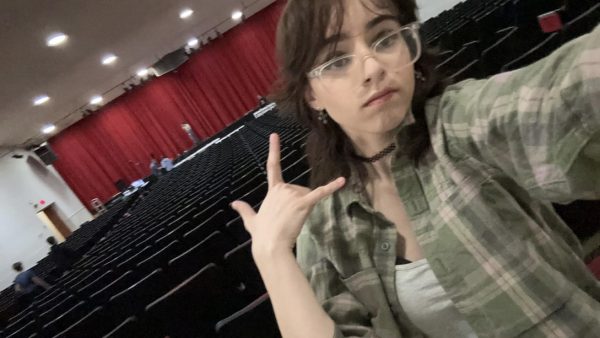When opening up Tik-Tok or Instagram, many users have been met with news about the Israel-Hamas war currently raging in the Middle East. College students all over the country have been participating in protests taking place on campus. Videos of protesters being arrested and forcibly exhumed have blown up on social media. High school students beginning their college search, or possibly beginning school next year, are worried about these institutions being flooded with antisemitism, violence, and discourse.
In a speech on May 2nd, President Biden said, “Destroying property is not a peaceful protest. It’s against the law. Vandalism, trespassing, breaking windows, shutting down campuses, forcing the cancellation of classes and graduations – none of this is a peaceful protest. Threatening people, intimidating people, instilling fear in people is not peaceful protest.”
But are these protests truly as violent as officials say?
A Firsthand Look at What Really Happens at These Protests
I spent the day down at UPenn’s College Green, where protesters have set up an encampment. UPenn student Sam*, stated the demands of the encampment: “[we] are asking for Penn to disclose its financial investments that contribute to Israels occupation, to divest from the companies that profit off of genocide, and to protect its Palestinian students and their community.”
Despite interim President J. Larry Jameson’s claims that the protest is “disrupting campus operations and events,” students involved in the protest were not obstructing student walkways or access to any buildings. Barricades set up by students protected these walkways. Outside of College Green, campus events and student life continued as normal with no disruption.

He also claims, “it is causing fear for many in our large, diverse community, especially among our Jewish students.” Throughout the day, in all their speeches and rallies, no comments were made about the Jewish community, only Israel as a country. No attacks or comments were made on the group of students protesting in support of Israel next to the encampment.
The protest was surrounded by Philadelphia Police and its Counter Terrorism unit armed with guns and bulletproof vests. No students attacked police or made any attempt to force them out of the area. More police lined the streets leading up to College Green. College administration could also be seen across from College Green watching the protests.

These protests were peaceful and only showed support of Palestinian civilians. There were no words of hatred towards any group of people. While everyone was encouraged to join the protests, no students were ushered into the area, and all were given a safe place to pass and walk through the college campus without disruption.
The Fallacy of Comparison: Reports of Antisemitism
Protesters at the University of Columbia, the institution at the center of these protests, have been criticized over reports that their peaceful, pro-Palestinian protests have been a front for antisemitism on campus. This disingenuous characterization has been one of the most egregious myths told about their peaceful encampments.
In a letter to President Shafik, the current president at Columbia, twenty-three Jewish faculty and staff wrote: “Labeling pro-Palestinian expression as anti-Jewish hate speech requires a dangerous and false conflation of Zionism with Jewishness, of political ideology with identity. This conflation betrays a woefully inaccurate understanding—and disingenuous misrepresentation—of Jewish history, identity, and politics.”
Protester organizer “CUNY for Palestine,” a network of students and workers rallying for Palestinian liberation have been vocal about their support for Jewish students around campus, calling out protestors who turn to antisemitism. Along with this, the Jewish Law Students Association of Columbia celebrated the Passover Seder at the CUNY Gaza Solidarity Encampment. Following the NYPD raid on Columbia, protest organizers stated, “publicly available accounts, including those provided by the NYPD, indicate that the protest encampment was peaceful and did not pose an imminent threat to public safety,” after students who camped out on the lawn were arrested along with those in Hamilton Hall.

Civil Disobedience is a Form of Free Speech, not “Lawlessness”
Many critics argue the protests are a disruption of the university environment, interrupting commencements, classes and daily life for students. In President Biden’s speech about the protests, he says, “So, let me be clear. Peaceful protest in America — violent protest is not protected; peaceful protest is. It’s against the law when violence occurs… shutting down campuses, forcing the cancellation of classes and graduations — none of this is a peaceful protest.”
Yes, civil disobedience disrupts or intrudes on the daily lives of people. This non-violent disruption is used to bring attention to an issue, in this case civilian lives in Palestine, and promote change.

What Biden describes as “violence” is a form of free speech deeply rooted in American history. One of the most famous examples is the Boston Tea Party. Colonists, fed up with Britan’s tax laws, threw 340 chests of tea into the sea. It was unconventional, but it was still a critical moment in US history. In 1917, at the peak of the women’s suffrage movement, thousands of women protested at the Senate, Capitol, and White House, all contributing to the achievement of women’s rights.
An article from the New Britain Daily Hearld in 1917 writes, “The women who do guard duty in front of the White House have overstepped the bounds of reason. By parading seditious signs, they have incited to riot.” Sound familiar? Campuses and ceremonies have not been interrupted by rioters ransacking the area but by students who are exercising their first amendment right to free speech.
Without protests like these, America wouldn’t be what it is today. If we pick and choose what people are allowed to say, we are oppressing the freedom of speech of Americans who are peacefully protesting and being punished for it.
* Speaker only gave first name








